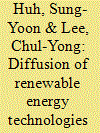| Srl | Item |
| 1 |
ID:
132658


|
|
|
|
|
| Publication |
2014.
|
| Summary/Abstract |
Renewable energy technologies (RETs) have attracted significant public attention for several reasons, the most important being that they are clean alternative energy sources that help reduce greenhouse gas emissions. To increase the probability that RETs will be successful, it is essential to reduce the uncertainty about its adoption with accurate long-term demand forecasting. This study develops a diffusion model that incorporates the effect of competitive interrelationships among renewable sources to forecast the growth pattern of five RETs: solar photovoltaic, wind power, and fuel cell in the electric power sector, and solar thermal and geothermal energy in the heating sector. The 2-step forecasting procedure is based on the Bayus, (1993. Manage. Sci. 39, 11, 1319-1333) price function and a diffusion model suggested by Hahn et al. (1994. Marketing Sci. 13, 3, 224-247). In an empirical analysis, the model is applied to the South Korean renewable energy market.
|
|
|
|
|
|
|
|
|
|
|
|
|
|
|
|
| 2 |
ID:
119804


|
|
|
|
|
| Publication |
2013.
|
| Summary/Abstract |
The Law 3468/2006 provided for first time in 2006 appealing feed-in tariff (FiT) incentives for photovoltaics (PVs) in Greece. The response of the national market was immediate in less than 2 years' time. Two subsequent laws formed an even more attractive investment and licensing context both for field and building installations, by introducing additional guarantees and improved grid-connection procedures. However, the unexpectedly large amount of applications submitted until 2011, with aggregate PV capacities which exceeded the national target for 2020 caused continuously tremendous delays in grid-connection processes. Undoubtedly, the effectiveness of this legislative framework cannot be judged solely by the response of prospective investors. In that sense, main objectives of this paper are to present and discuss about the effective provisions as well as the major weaknesses of the FiT legislation in Greece since 2006, associated mainly with its attractiveness to investors and its cost-effectiveness towards preserving and supporting the Greek PV market. The paper concludes with a technoeconomic assessment, which evaluates PV projects' viability, especially those ones whose provision of grid-connection offer was postponed several times.
|
|
|
|
|
|
|
|
|
|
|
|
|
|
|
|